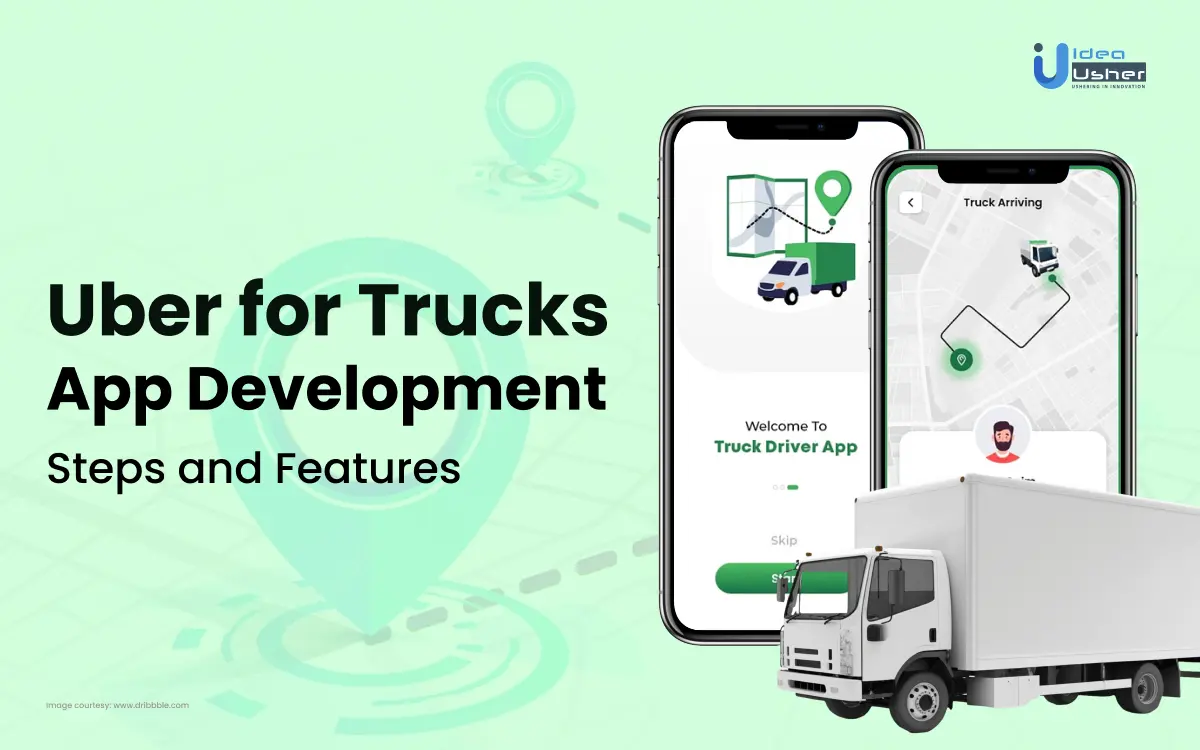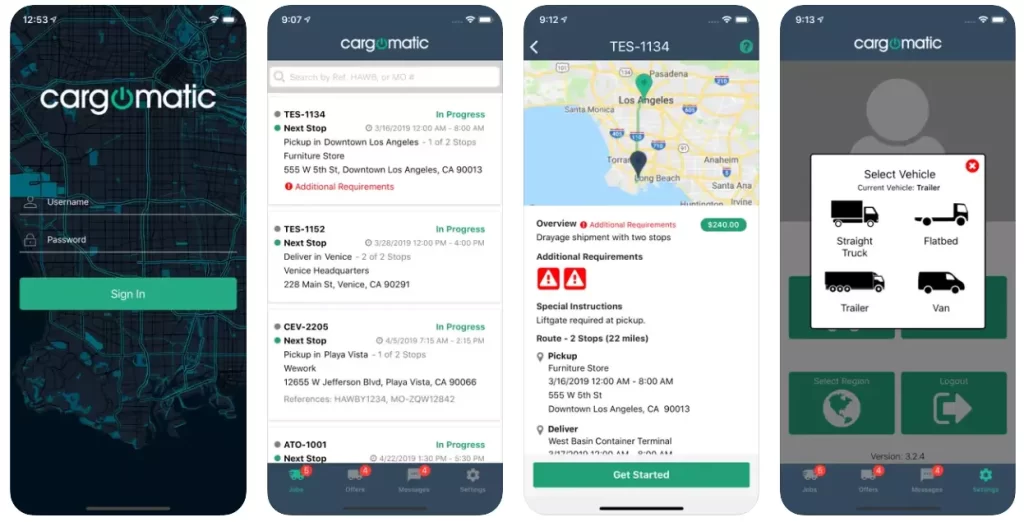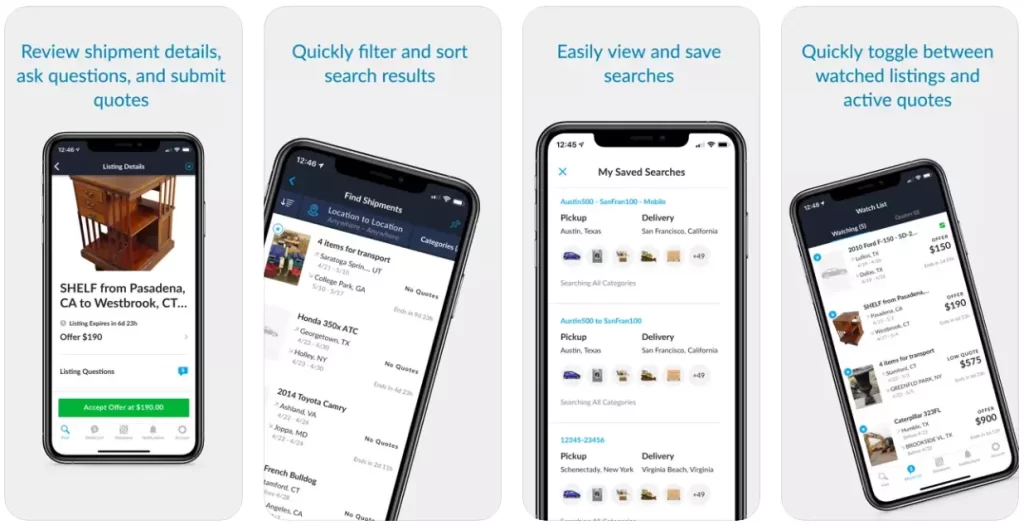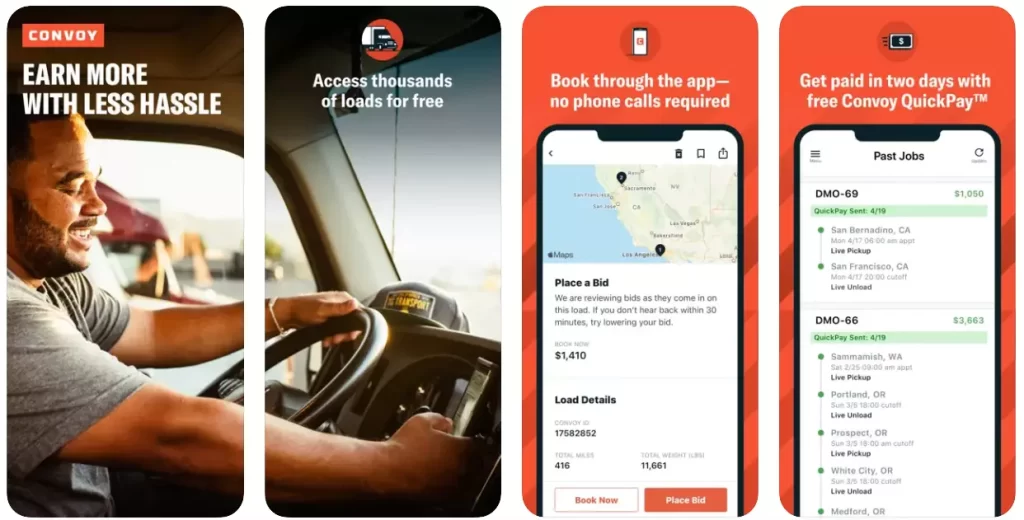- What Is Uber For Trucks Apps?
- How Trucking Applications Work?
- Future Potential And Business Growth Of Trucking Application
- Top 5 Trucking Applications
- Must Have Features For An On-Demand Trucking App
- How To Develop An Uber-Like App for Trucks?
- Technical Stack For Uber-Like Trucking App Development
- Conclusion
- FAQ

From ordering delicious pizza via UberEats or watching favorite series on Netflix, the on-demand economy has entirely revolutionized how people consume goods and services.
The same on-demand business model can also be applied to trucking applications. In today’s fast-paced world, the transportation industry has become crucial in connecting businesses and individuals with the goods and services they need.
The trucking applications have streamlined how shippers and customers ship their products by successfully collaborating with available truck drivers and logistics providers. There is a great investment opportunity for individuals seeking to make profits with application development in the freight trucking industry.
The noticeable success of many on-demand transportation applications, such as Uber Freight, indicates how profitable is to invest in the transportation industry with app development.
Explore the working of trucking applications, app development steps, and required technical stack if you consider building an Uber for trucks app.
- What Is Uber For Trucks Apps?
- How Trucking Applications Work?
- Future Potential And Business Growth Of Trucking Application
- Top 5 Trucking Applications
- Must Have Features For An On-Demand Trucking App
- How To Develop An Uber-Like App for Trucks?
- Technical Stack For Uber-Like Trucking App Development
- Conclusion
- FAQ
What Is Uber For Trucks Apps?
A digital trucking marketplace platform that connects shippers with trucking service providers.
The platform operates similarly to popular ride-hailing services like Uber, but instead of matching passengers with drivers, they connect truck drivers or carriers with shippers. The trucking application provides a convenient way for shippers to find and book available trucking service providers.
The trucking applications help logistics operators to improve their services and asset utilization by providing them with cost-effective transportation solutions. Many trucking applications, such as Convoy, Uber Freight, Doft, etc., utilize the technology of trucking applications to facilitate efficient collaboration between shippers and trucking companies.
How Trucking Applications Work?
The trucking app connects truck drivers with individuals or businesses that require transportation services. Here is a step-by-step process of how the truck app works.
1. User Registration
Individuals such as users, shippers, businesses, and truck drivers register on the platform by submitting their basic details such as contact information, name, payment information, e-mail address, etc.
2. Load Posting
Shippers, such as users or businesses, post details of their cargo on the app, including pickup location, type of cargo, destination, weight, or any other specific information.
3. Load Matching
The applications match the available loads with nearby or suitable truck drivers based on various factors such as capacity, location, availability, and other preference of truck drivers.
The trucking application utilizes several algorithms to ensure the efficient matching of truck drivers with their customers.
4. Driver Acceptance
The truck driver can review the loading details to decide whether they would be able to ship the particular order or not. The driver is free to accept or reject the loading request based on their availability and preferences.
5. Trucking and Communication
After the driver accepts the order, the app will provide real-time tracking information, such as trucks, location, and an estimated arrival time to the shipper. Moreover, the application will facilitate communication between the driver and shipper for any necessary clarifications or updates.
6. Delivery Confirmation and Payment
The shipper confirms the successful completion of the delivery through the app once the cargo is delivered to the location that the shipper decided. The logistic cost is calculated based on various factors such as predetermined rates, additional services, distance traveled, or any other applicable fees.
Many trucking applications come with integrated payment gateways that enable shippers to pay directly through the app to truck drivers or loading businesses.
7. Ratings and Reviews
The feature enables shippers to rate and review the trucking services of different drivers and logistics businesses. Ratings and reviews maintain the quality and trust within the platform.
8. Additional Features
Many trucking applications offer additional features to enhance the functionality of their platforms, such as in-app chat, customer support, alerts, notifications, etc. Offering additional features help trucking applications to stay competitive and profitable in the market.
However, one should keep reminded that the specific workflow of a trucking application can vary based on the target audience, business models, and customized requirements of the app.
Future Potential And Business Growth Of Trucking Application
There is significant future potential for trucking application development as the trucking industry plays a crucial role in the global economy. The trucking apps streamline the transportation process and ensure the smooth running of supply chains.
Take the example of Uber Freight (a trucking platform launched in 2017), have witnessed a great impact on their business with application development.
Here are some of the business impacts on digital trucking platforms worth noticing from Uber Freight after trucking application development.
1. Enhanced Efficiency
The mobile application has streamlined the booking process, reducing the time and effort for shippers to find available carriers. The application enables shippers to find and book trucking companies in a more efficient way.
2. Increased Visibility and Transparency
Uber Freight benefits shippers to make informed decisions by offering them a great level of visibility and transparency (fostering trust and improving overall customer experiences).
3. Improved Utilization
The application optimizes their capacity by providing them access to a broad network of loads and shippers. The broad network enables app users of Uber Freight to minimize empty backhauls and maximize their revenue by leveraging the platform’s demand and supply matching capabilities.
4. Expansion and Market Penetration
Uber Freight has expanded its operation across various regions of the United States, where the platform managed to attract both carriers and shippers.
5. Digital Transformation of the Industry
The innovative features and seamless user experience have raised the industry standards of the traditional trucking industry, accelerating its digital transformation.
Top 5 Trucking Applications
It will be crucial to know your competitors to become successful in an on-demand trucking business. You may need to give more value to your app users to stay ahead of your competitors.
Explore the leading players in the on-demand trucking industry.
1. Cargomatic

A California-based trucking company that connects shippers with truck drivers. The platform allows delivery with competitive prices based on various factors such as weight, size, and distance of the cargo.
Users can select drivers based on their financial security rating, reputation, and available equipment. The platform offers two types of apps such as the driver app and the shipper app. The driver app facilitates drivers to apply for jobs, check the supply availability, select driving routes, and send documents.
On the other side, the shipper app allows the shipper to contact drivers, check shipment history and rate the drivers based on their service quality, etc.
- Founded in: 2013
- Owned by: Brett Parker & Jonathan Kessler
- Available on: Android & iOS
- App Downloads: 10K+
- App Ratings: 3.9
- Headquarters: Long Beach, California, United States
2. uShip

A popular marketplace for shippers and drivers that facilitates all kinds of shipments. The platform corporates with all kinds of truck drivers, such as solo truckers as well as large companies.
The uShip app comes with various useful features, such as price estimates, real-time tracking, and notifications, an in-built payment system, etc.
- Founded in: 2003
- Owned by: Matthew Chasen
- Available on: Android & iOS
- App Downloads: 500K+
- App Ratings: 3.5
- Headquarters: Austin, Texas, United States
3. Uber Freight

The application facilitates collaboration between truck drivers and shippers. Truck drivers receive shipment requests from shippers based on cargo types such as load type, weight, and size.
The shippers can explore different carriers in a matching section by reading reviews and selecting genuine truck drivers to ensure their shipments will be delivered on time.
- Founded in: 2016
- Owned by: Uber Technologies
- Available on: Android & iOS
- App Downloads: 100K+
- App Ratings: 4.3
- Headquarters: San Francisco, California, United States
4. Convoy

An online trucking marketplace where shippers can contact different truck drivers based on their shipment needs and preferences. The application provides various useful features like pay request detention, accessing pick-up and drop-off time, etc.
However, Convoy only collaborates with trucking companies that have DOT numbers & insurance in addition to motor carrier authority.
- Founded in: 2015
- Owned by: Dan Lewis; Grant Goodale
- Available on: Android & iOS
- App Downloads: 100K+
- App Ratings: 4.0
- Headquarters: Seattle, Washington, United States
5. Doft

An on-demand trucking application where shippers can book trucks from independent commercial truck drivers. The Doft application has been classified into two parts i.e., app for shippers and app for drivers.
The app for shippers offers a variety of useful features, including real-time tracking of cargo shipping, booking prepaid or regular on-demand tools, in-app chat support, real-time notification regarding shipment delivery status, etc.
While drivers on the driver app can provide shipment services to shippers by accessing the following features such as fuel surcharge calculator, upfront pricing and prepaid loads, average market rate forecast, etc.
- Founded in: 2016
- Owned by: Aliya Salakhova, Dmitri Fedorchenko, Sergey Zaturanov
- Available on: Android & iOS
- App Downloads: 100K+
- App Ratings: 4.6
- Headquarters: Greater Los Angeles Area, West Coast, United States
Must Have Features For An On-Demand Trucking App
The Uber trucking app consists of three different applications, i.e., the driver app, the shipper app, and the admin app.
I. Driver’s App
The application will enable drivers to fill their trucks with accepted orders and deliver them to the decided destination. To streamline the entire process, ensure the following features are included in the driver’s app.
1. Registration
The feature will enable drivers to create their accounts on trucking applications by submitting required details such as their name, e-mail address, etc.
2. Route optimization and trucking
The feature is helpful for drivers to track the routes in real-time so they can decide and select the appropriate one based on various conditions, including road repairs, traffic conditions, accident status, etc.
3. Filtering and sorting
The feature will help shippers to easily sort out their shipment details by applying different filters such as cargo type, pickup, destination location, date, etc.
4. Shipment details
The drivers can access all the important information related to the cargo and loads before accepting shipments, such as their weight, type, dimensions, pick-up, and drop-off location and date, type of delivery and pickup, etc.
5. Request cancellation
In an emergency or unavailability, the driver can cancel the shipment request. After the request cancellation, the shipper can contact other drivers for shipping and delivering their loads.
6. Proof of delivery
After the successful shipment of a particular load, the driver can submit proof of delivery to the shipper by simply uploading the document or a photo.
II. Shipper’s App
The shippers can utilize a shipper app for accessing load delivery services by contacting different truck drivers and logistics businesses through the app.
1. Registration
Like truck drivers, shippers also need to create their accounts on the trucking app.
Shippers can submit their basic details such as their name, e-mail address, contact details, etc., which would help truck drivers and logistics delivery businesses to contact them.
2. Ratings and reviews
The feature will enable shippers to rate and review their logistic delivery experience from different drivers and logistics delivery companies.
The rating and review feature will establish trust as shippers can know and contact the genuine truck drivers and logistic companies available on your platform.
3. Notifications & alerts
The alerts and notification feature will help shippers to know the status of their shipment delivery even without opening the app. The feature will provide updates at each stage of the shipment.
4. List of vehicles
The feature will showcase the list of all the available vehicles that are present in a particular area, along with their necessary details.
5. Multiple payment options
Enabling multiple payment options will allow shippers to pay for logistic delivery services by making payments to drivers or available logistic delivery companies.
Integrate popular payment options such as cash, e-wallet, and credit/debit cards to avail shippers to pay based on their preferred payment.
6. Real-time vehicle trucking
The feature will allows shippers to know the real-time status of their shipment by trucking the vehicle carrying the shipment products, such as their location, estimated arrival time, etc.
III. Admin’s App
The admin, the owner of the app, will access the following features to entirely manage their infrastructure, including shippers, carriers, trucks, cargo, etc.
1. Bill management
The feature will enable the admin to verify and approve invoices generated through the application regarding the completion of delivery and payment processed by the shipper.
2. Dashboard
The dashboard will enlist all the important information regarding vehicles, carriers, shippers, and order status (both pending and completed).
3. Truck drivers
The admin can use this feature to track the location of the drivers and provide necessary details to shippers, such as estimated delivery time, estimated delivery cost, etc.
4. Notifications
With this feature, the admin can send important notifications to the carriers regarding changes in delivery location, routes, etc. The dashboard will enlist all the important information regarding vehicles, carriers, shippers, and order status (both pending and completed).
How To Develop An Uber-Like App for Trucks?
The development process for trucking applications involves strategic planning across different areas of app development, such as from defining project scope to launching your app to your targeted market.
Here is a step-by-step procedure for developing an Uber-like app for trucks.
Step 1. Decide what kind of logistics app you want to develop
There are two different scenarios for starting an Uber-like trucking app development.
In the first option, you will start your own logistic business where you will take shipping orders from shippers and deliver them to their preferred destination.
While for the second one, you will offer a marketplace where carriers can accept orders from shippers, and you will earn money as a commission on each successful delivery.
Step 2. Find a development company for your logistics and transportation mobile app
There are two ways to hire an app development company for your logistics app development. The first one is to hire in-house app developers, while the other one is outsourcing your project to an app development company.
Outsourcing your project to an app development company offers many benefits over hiring in-house app developers, such as greater flexibility in terms of pricing, app maintenance, development, expertise, etc.
Here is a complete guide on how to hire app developers in 2023 for your project.
Step 3. Validate your idea
After exploring and finding the appropriate app development company for your project, you can reach out to help them to validate your app idea.
App validation is a crucial part that can help you avoid wasting your effort, time, and cost in truck app development as you can figure out whether your idea will be profitable in the long run. Validation of an app idea includes in-depth market research, competitor analysis, feedback from potential customers, etc.
Step 4. Decide on features for an MVP/MLP
MVP stands for Minimum Viable Product which includes the basic features of a trucking app to make your app fully functional and ready to access and launch. Consider launching an MVP version of your trucking app to gather feedback and figure out weak points and strengthen them by taking feedback from your potential customers during its testing phase.
Step 5. Launch your app
After preparing the MVP version of your trucking application, you can deploy them to your targeted platforms, such as mobile devices, websites, Desktop software, etc. Ensure to follow the proper guidelines of all app publishing platforms you consider for distributing your app among your potential customers.
Technical Stack For Uber-Like Trucking App Development
Several tools and technologies can be utilized to develop different components of an Uber-like trucking application.
Here’s a suggested tech stack that you can consider:
1. Front-end Development
- User interface: JavaScript (React, Angular, or Vue.js)
- App structuring and styling: HTML and CSS
- Managing application state: Redux or similar state management libraries
- Making HTTP requests to the server: Axios or Fetch API for
2. Back-end Development
- Building the back-end: Node.js or a similar server-side JavaScript runtime environment
- Handling server-side routing and API development: Express.js or another web framework
- Database: PostgreSQL, MySQL, or MongoDB
- Authentication: JSON Web Tokens (JWT) or OAuth for user authentication and authorization.
- Real-time communication between drivers and users: WebSocket
- Location-based services: Geocoding and mapping APIs (e.g., Google Maps API, Mapbox API) for
- Payment gateway integration: Stripe or Braintree
3. Mobile App Development
- For iOS: Swift programming language with the native iOS development framework.
- For Android: Kotlin programming language with the native Android development framework.
- Hybrid frameworks: React Native or Flutter
4. DevOps and Infrastructure
- Containerization and deployment: Docker
- Managing containers: Kubernetes or similar container orchestration platform for
- Application Hosting: Cloud platforms: Amazon Web Services (AWS), Google Cloud Platform (GCP), or Microsoft Azure
- Automated building, testing, and deployment processes: Continuous Integration and Continuous Deployment (CI/CD) tools like Jenkins, Travis CI, or GitLab CI/CD
It’s crucial to remember that the selection of technology might change depending on your team’s skills, scalability demands, and particular business requirements.
Also app performance, optimization, scalability, and security procedures should also be considered for selecting an appropriate tech stack.
Conclusion
The trucking app development represents a significant step toward modernizing the logistics sector.
The Uber-like app development for the trucking industry can leverage various technologies such as geolocation, mapping APIs, and cloud infrastructure to facilitate effective collaborations between shippers and truck drivers.
However, the development of trucking applications requires expertise in various domains of application development, such as programming, UI/UX development, API integration, etc. Therefore working with a reliable app development company can be a wise decision to simplify the Uber-like trucking app development process.
Work with us if you are looking for an app development company to help you at each stage of the app development process, from validating your app idea to building and publishing your trucking app to your targeted market.
Contact us today to learn how we can help you establish and scale your trucking business.
FAQ
Q. How do I make an Uber-like app for my truck?
A. Consider following the given steps to build your Uber-like app for the trucking industry: Decide the type of trucking app you want to develop, Find a development team for your logistics and transportation mobile app, Validate your trucking app development idea through market research and competitor analysis, Create MVP of your app by building and implementing a limited number of app features, Launch and deploy your trucking app.
Q. Which app is used for trucking?
A. Uber Freight, Convoy, Cargomatic, Doft, and uShift are some of the best apps which are used for trucking.
Q. What are the advantages of transportation app?
A. The transportation app offers many advantages, such as enhanced efficiency, real-time tracking and visibility, seamless coordination, data analytics, and insights













Gaurav Patil